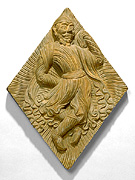
China, Tang dynasty, reign of Taizong (627-50)
From the Red Pagoda of Xiuding Temple
Anyang, Henan province
Grey pottery with reddish slip
Height: 53.7 cm
Acquisition number: #B60 S74+
The Avery Brundage Collection
Image courtesy of the Asian Art Museum of San Francisco (Copyright reserved)
Due to a lack of an archaeological context, as well as its unusual subject matter, the authenticity of this architectural tile was questioned until recently. It is now confirmed that the tile's origin is the Red Pagoda at Xiuding Temple, a structure decorated with sculpted tiles very similar to this one. The unusual nature of this ruin had been kept hidden by the local population, who covered the surface of the structure with plaster to hide the tiles from looters.1
Xiuding Temple was first built in sometime around the year 500 CE, only to be destroyed in 576 during a period when Buddhism suffered severe persecution. It was rebuilt during the Sui dynasty (581-618 CE) as an offering to the spirits of soldiers killed in China's Central Asian frontier.2 This dancer is but one unusual feature of the pagoda's tile work, as the overall design incorporates a number of Central Asian cultural and design elements. The overall arrangement of tiles resembles a nomad's tent, held up by pillars decorated with patterns possibly derived from Sassanian textiles or metalwork. Other tiles incorporated more traditional Chinese and Buddhist motifs. A number of other Central Asian figures appear as well, and the distinctiveness with which their physical features and their costumes are portrayed have led Chinese scholars to hazard a guess as to their ethnic origins. In this case, this figure is believed to be of the Hu ethnicity, the Hu being a nomadic people who dwelled on the Tang dynasty's northern frontier.3
References:
(1) The Asian Art Museum of San Francisco: Selected Works (San Francisco: The Asian Art Museum of San Francisco, 1994), p. 101.
(2) Ibid.
(3) Ibid.